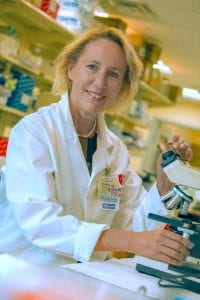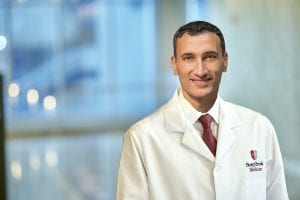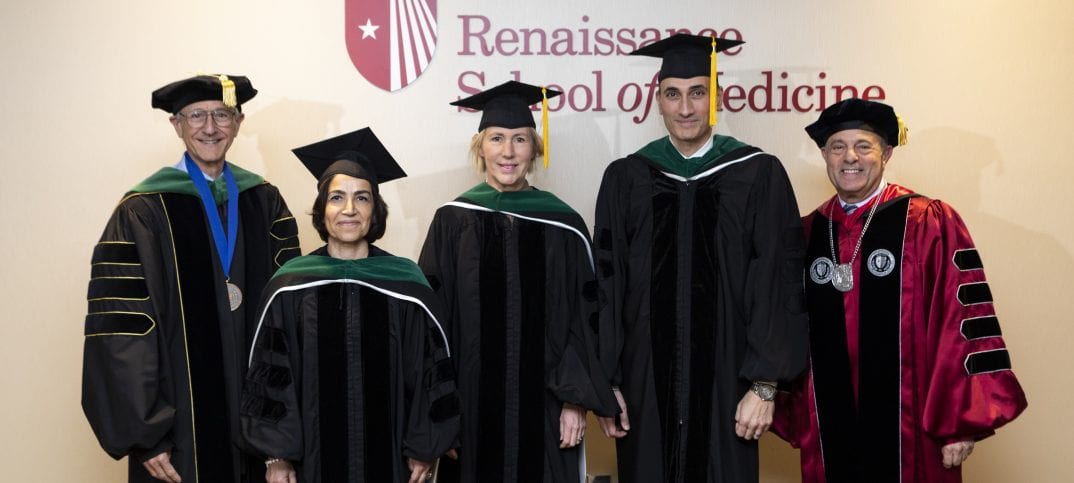By Daniel Dunaief
A heart and lung doctor, a researcher who works on imaging for schizophrenia and a scientist working with a mutation that affects cancer last month received endowed inaugural chair positions at Stony Brook University.
Ute Moll is the Renaissance Endowed Professor in Cancer Biology, Anissa Abi-Dargham is the Lourie Endowed Chair in Psychiatry and Henry Tannous is the General Ting Feng Cheng Endowed Chair in Cardiothoracic Surgery.
In addition to adding the prestigious titles and winning support from local benefactors and philanthropists, the three researchers will each receive annual financial support from their positions that will sustain their research and education efforts. TBR News Media is highlighting the research from each of these standout scientists.
Ute Moll

A native of Germany, Ute Moll, who is studying the six most common mutated forms of the highly researched p53 gene, is grateful for the donors, the funds and the recognition. “It’s pretty prestigious to have an endowed chair or professorship attached to your name or title,” she said
Moll described the p53 mutations as the “most common mutation in cancer.” She has been working with a mouse model. The p53 R248 hotspot is the single most common variant in all p53 altered tumor types, which occurs in about 66,000 newly diagnosed cancer patients in the United States each year.
If these mice also have a gene called Myc, they get either liver or colon cancer. By receiving an estrogen derivative drug called Tamoxifen, which is used in breast cancer, the active, mutated version of the p53 gene is turned off when another gene called Cre recombinase is activated. By removing the p53 gene, the mice live two to three times longer than they would have.
In a typical mouse, cancer can cause over 100 tumor nodules, leaving almost no normal liver. When Moll and her colleagues turned off the mutant gene, the size of the cancer is much more limited, with only a few remaining nodules.
One particular mouse lived for more than two months, eventually dying of an unrelated lymphoma. The liver, however, which had an infection across the entire organ, didn’t show a single trace of a tumor. It was completely normal, despite the ubiquitous tumor nodules before treatment.
Thus far, targeting this mutated p53 is a concept Moll and her colleagues have developed in pre-clinical mouse models of lymphoma, colon and liver cancer, but it doesn’t yet have a clinical application.
Liver cancer used to be relatively rare in the population, driven largely by infection from hepatitis B and hepatitis C, as well as through alcoholism. Amid an epidemic of obesity, people are developing a chronically inflammatory liver condition, which increases the incidence of liver cancer.
Anissa Abi-Dargham

A specialist in Positron Emission Tomography (or PET) imaging for schizophrenia, Anissa Abi-Dargham is pleased with the opportunity to deploy the funds for her work at her discretion.
“The beauty of these funds is that they are totally flexible,” she explained, adding that she plans to use the funds to pursue new research ideas that might not otherwise get funding until she can use data to prove a concept or principal.
“This is really a great honor because it means that the institution believes in you and wants to invest and retain you,” she said.
In her work, Abi-Dargham has been using imaging to see what is causing dopamine dis-regulation, either with too much or too little of the neurotransmitter.
She is looking at two systems that may explain the imbalance: the cholinergic system and the kappa opioid system.
Abi-Dargham had been at Columbia University for 20 years before joining Stony Brook over three years ago. She appreciates the school investing in a state-of-the-art imaging center. “The people in charge of this imaging center are very much investing in promoting imaging for neuroscience and psychiatry,” she said.
Based on her findings in schizophrenia, other investigators in the United Kingdom have documented dopamine levels before schizophrenia symptoms begin.
She hopes her research discovers biomarkers that can be used to predict who is going to convert to having schizophrenia.
Patients do better when the onset of symptoms is later in their lives because their more mature brain has fostered better organized life, skill sets, and relationships.
She is also testing whether other markers, such as a neuromelanin, which is a metabolite of dopamine and binds iron-like materials, will show up on a Magnetic Resonance Imaging scan before the disease.
Henry Tannous

Henry Tannous joined Stony Brook University in 2016 and is excited to be a part of the current team and to help shape the future of clinical practice and research.
Tannous called the endowed chair position an “absolute honor.” It will not only allow him to continue with his current work, but it’s also going to enable him to expand his research. He will also use some of the funds to provide continuing education for his staff.
The financial support will allow him to hire research assistants and access national databases. Tannous and his research team of cardiothoracic and lung scientists use registries from the New York State Department of Health registry and the Society of Thoracic Surgeons, each of which provides the data for a price.
With his lung work, Tannous focuses on state 1 lung cancer. Traditionally, he said, people have received a diagnosis late in the development of the disease. Over the past few years, doctors have diagnosed patients at an earlier point.
Earlier diagnoses became more prevalent after Medicare approved lung cancer screening in 2015, which picked up more cases while patients were still in the earlier stages, when the cancer might otherwise be asymptomatic.
“We would like to know more about how the disease affects [patients] and their quality of life,” Tannous said. His lab has a collaboration with Mount Sinai Hospital to learn more about the effect of the disease on the lives of the patients.
With his heart research, he’s focusing on aortic disease and is testing the limits of the Trans Catheter Aortic Valve Replacement.
Photos courtesy of SBU







